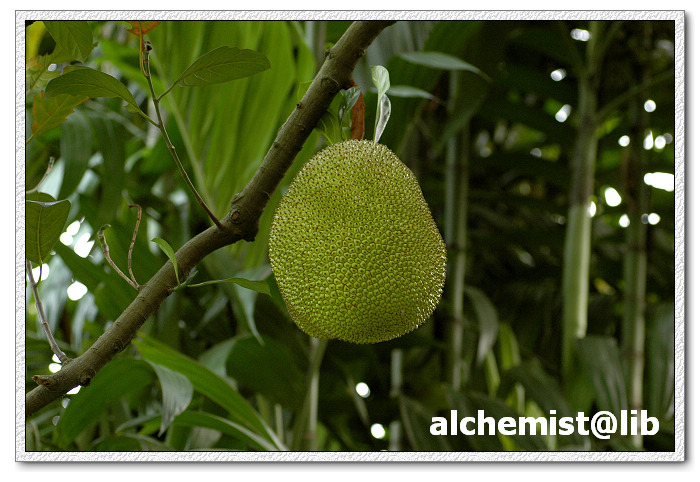- Scientific Name: Artocarpus heterophyllus Lam.
- Ref: Encycl. 3:29. 1789
- Synonyms: Artocarpus brasiliensis Gomes; A. maximus Blanco; A. philippensis Lam.; Sitodium cauliflorum Gaertn.; Saccus heterophyllus (Lam.) Kuntze
- English Common Name: jackfruit, jack tree
- Chinese Common Name: 波罗蜜 bōluómì, 木波罗 mùbōluó
- Japanese Common Name: パラミツ [波羅蜜] paramitsu
- Family: Moraceae
- Genus: Artocarpus
- Distribution: Cultivated;; Low elevations. Guangdong, Guangxi, Hainan, S Yunnan [native to India; cultivated throughout the tropics].
- Photo: 06/21/2009, South China Botanical Garden, Guangdong
Trees 10-20 m tall, d.b.h. 30-50 cm, evergreen. Mature trees with tubular roots. Bark blackish brown, thick. Branchlets furrowed to smooth, 2-6 mm thick, glabrous. Stipules amplexicaul, ovate, 1.5-8 cm, with or without bent pubescence, caducous, scar annular and conspicuous. Leaves spirally arranged; petiole 1-3 cm; leaf blade elliptic to obovate, 7-15(or more) × 3-7 cm, lobed on new growth of young trees, leathery, abaxially pale green and with scattered globose to ellipsoid resin cells, adaxially dark green, glabrous, and shiny, base cuneate, margin of mature leaves entire, apex blunt to acuminate; midvein abaxially conspicuously prominent, secondary veins 6-8 on each side of midvein; leaves on mature trees entire. Inflorescences on old stems or brachyblasts. Male inflorescences axillary on apical branchlet, sometimes axillary on axillary brachyblasts, cylindric to conic-ellipsoid, 2-7 cm, many-flowered but some sterile; peduncle 1-5 cm. Female inflorescences with a globose fleshy rachis. Male flowers: calyx tubular, apically 2-lobed, 1-1.5 mm, pubescent; filament straight in bud; anther ellipsoid. Female flowers: calyx tubular, apically lobed; ovary 1-celled. Fruiting syncarp pale yellow when young, yellowish brown when mature, ellipsoid, globose, or irregularly shaped, 30-100 × 25-50 cm, with stiff hexagonal tubercles and thick hairs. Drupes narrowly elliptic, ca. 3 × 1.5-2 cm. Fl. Feb-Mar. (Flora of China)
